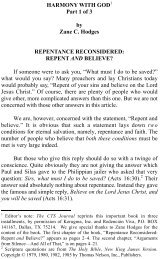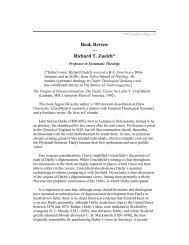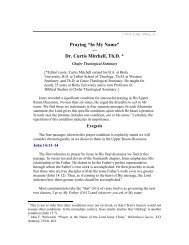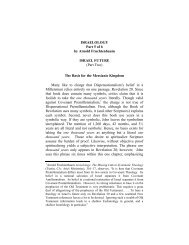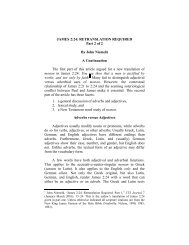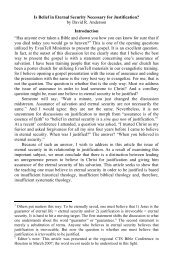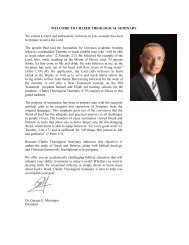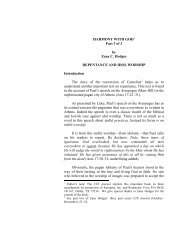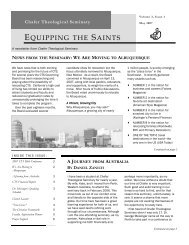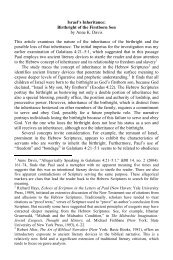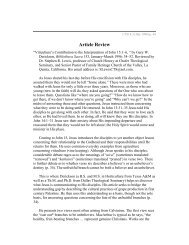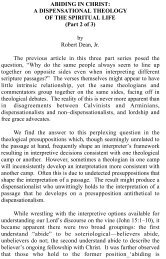Biblical Theology: An Evangelical Approach by David J. MacLeod ...
Biblical Theology: An Evangelical Approach by David J. MacLeod ...
Biblical Theology: An Evangelical Approach by David J. MacLeod ...
Create successful ePaper yourself
Turn your PDF publications into a flip-book with our unique Google optimized e-Paper software.
<strong>Biblical</strong> <strong>Theology</strong> 41motif. This theological center, as noted above, will provide the framework forthe arrangement and presentation of the theological materials. 77Arranging the Materials. Using the thought forms and categories of thebiblical author, an outline can now be developed. The materials should bearranged around the doctrinal center and reflect the author’s own emphasesand doctrinal sequence.SummaryIt has been argued in this article that <strong>Biblical</strong> <strong>Theology</strong> is a scientific (i.e.,systematic) discipline, that it pays attention to the historical context, that itemphasizes the progressive nature of revelation, and that it is biblical. It hasbeen affirmed that there are certain operating presuppositions, whichdistinguish the evangelical practice of the discipline. Furthermore, it has beenargued that although <strong>Biblical</strong> <strong>Theology</strong> differs from Systematic <strong>Theology</strong> inprecedence, purpose, perspective and content, the two are reciprocaldisciplines. Also, it has been argued that the historical method is superior tothe thematic method. Finally, a methodological process involving four steps(exegesis, argument, theme, and outline) has been proposed.ConclusionIn conclusion, the writer of this article would like to say something about itstitle, “<strong>Biblical</strong> <strong>Theology</strong>: <strong>An</strong> <strong>Evangelical</strong> <strong>Approach</strong>.” For some readers theterm “evangelical” is such a broad category that it is almost meaningless touse it. John Stott, for example, has recently referred to the “57 varieties ofevangelicalism,” 78 and Clive Calver has spoken of “the twelve tribes ofevangelicalism.” 79 On a more serious note, <strong>David</strong> Wells has spoken of threedifferent trends in evangelicalism that have emerged since World War II:“confessional, transconfessional, and charismatic.” 80 The first of hiscategories he also calls “conservative, or ‘definite.’” 8177 For the present writer’s effort at establishing the center of a New Testament book,see <strong>David</strong> J. <strong>MacLeod</strong>, “The Doctrinal Center of the Book of Hebrews,” BSac 146(July 1989): 291–300.78John Stott, <strong>Evangelical</strong> Truth: A Personal Plea for Unity, Integrity andFaithfulness (Downers Grove: IVP, 1999), 22. Stott attributes his remark to theunnamed editor of The Church of England Newspaper (April, 1998).79 Clive Calver and Rob Warner, Together We Stand (London: Hodder and Stoughton,1996), 128–30.80<strong>David</strong> Wells, “On Being <strong>Evangelical</strong>: Some Theological Differences andSimilarities,” in <strong>Evangelical</strong>ism: Comparative Studies of Popular Protestantism inNorth America, the British Isles and Beyond, 1700–1990, ed. Mark A. Noll, <strong>David</strong> W.Bebbington, and George A. Rawlyk (New York: Oxford University Press, 1994),389–410 (esp. 391–92). (1) “Confessional” or “conservative” describes the movement



